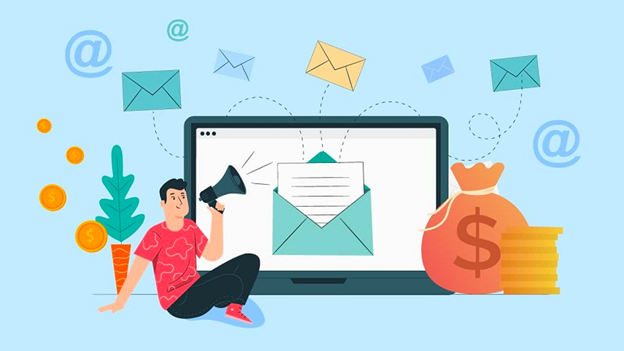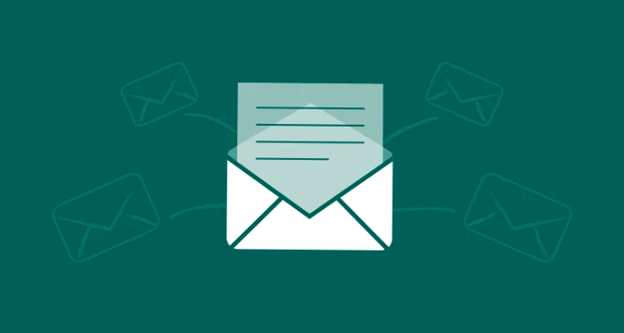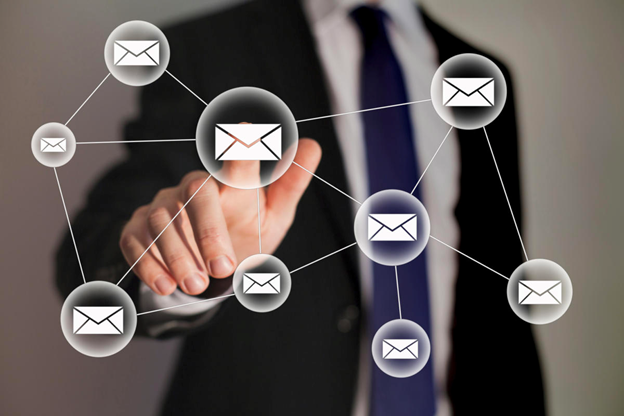What is Email Marketing? The Ultimate Guide!
Email marketing is unquestionably a highly successful online marketing channel that can be used to generate leads and drive high-quality traffic during the customer journey.
However, as effective as email marketing can be, customers are still jaded about it. If you don’t have a well-thought-out plan, your email marketing strategies may be overlooked, and you might even lose the trust of your customers.That’s why we have put together this guide in which you’ll find the steps to master the fundamentals of email marketing.
You will learn what email marketing is, how it works, and how to create, analyze, and optimize your email marketing campaigns. Let’s jump right into the details.
What is email marketing?

Email marketing is a digital marketing technique that helps you achieve your marketing goals by sending emails to a list of prospects who have subscribed to your list. These emails can include anything from helpful details, business news, ads, promotional deals to requests for a sales meeting.
They are often tailored to the prospects’ demographics or stage in the sales funnel. To monitor email lists and track progress, businesses usually use an email marketing services. Is email marketing still a viable strategy? Although new online marketing platforms emerge, most marketers still consider email the most powerful medium for reaching your target consumers, being 40 times more effective than social media.
The below statistics will help you understand why you should invest in this marketing channel:
-
Since email is so widely used, you can easily access many recipients from all walks of life. There are over 3.9 billion email users globally, with that figure expected to rise to 4.3 million by 2023.
-
Among widely used marketing platforms, email marketing has one of the highest ROIs. When done correctly, you can expect a return on investment of $42 for every dollar invested!
-
Because of its low cost and efficacy, email marketing can be implemented by businesses of any scale. In reality, 81 percent of small and medium-sized businesses (SMBs) believe email is their most successful customer acquisition and retention platform.
-
Email is making a comeback, with 78 percent of marketers reporting a rise in email engagement in 2019. It has the ability to break through the noise and create relationships with the viewer.
-
Customers prefer to receive emails from their favorite brands instead of other ways of communication. 49 percent of customers want to receive promotional emails on a weekly basis.
Advantages and disadvantages of email marketing

Advantages of email marketing
Email marketing has many advantages in itself:
-
Cost-effective. Email marketing can be much more cost-effective than many other types of marketing. There are no fees for ads, printing, or media space.
-
Permission complied. Permission-based email marketing means that your marketing list would consist of individuals who have voluntarily agreed to accept email messages from you. Customers who are truly interested in your goods and/or services are more likely to buy from you.
-
Versatile. You can send plain text, images, or attach files, depending on what best fits your content style. A variety of design choices allows you to express your company’s branding.
-
Scalable. Email marketing is scalable in that it can be used to reach broad audiences as well as smaller targeted lists.
-
Higher personalization. You can personalize messages through email marketing. You can also segment your mailing list so that your customers only receive messages that are relevant to them - this will increase their interaction with you.
-
Shareable. It is simple for people to forward and share your email, allowing you to develop your credibility through word-of-mouth or viral marketing.
-
Measurable. Using web analytics tools, you can assess the effectiveness of a campaign. You can easily evaluate different copies, subject lines, and designs to see which ones work best. This enables you to improve future campaigns.
-
Expectable. There are tons of email marketing data available that allow you to equate your performance to those of those in your field. There are several free email marketing benchmarking reports available online; simply search for them. Benchmarking data will assist you in evaluating and prioritizing opportunities for change.
-
Testable. You can A/B test subject lines, calls-to-action, personalization, email copy, photos, or messages before sending. Before you send an email, make sure the content is as optimized as it can be.
-
Less invasive. Unlike phone ads, recipients can read your message when it is convenient for them. Customers may either change their preferences if they wish to accept different messages from you, or they may unsubscribe if they no longer want to hear from your email.
-
Time-saving. Via automation which you can do with probably any email marketing app that you use, you can send emails to customers based on an activity they took on your website, such as sending a welcome email when a user signs up for your website or sending an email providing a discount reward if a user abandons an online shopping cart. Once you’ve created a template, you can reuse it for multiple email campaigns.
-
Real-time marketing. Email marketing allows you to communicate with customers in real-time. You can reach the right audience, at the right time, in the right place, and with the right offer by using automated triggers such as recent purchases or cart abandonment savers.
Disadvantages of email marketing
Despite all of its advantages, email marketing does have some disadvantages that you might want to pay attention to:
- Spam. Commercial email, also known as ‘spam,’ irritates customers. If your messages aren’t being delivered to the right people, the recipient may delete or unsubscribe.
You must ensure that your email marketing is in accordance with privacy and data security regulations and that it is appropriately targeted at people who choose to receive it.
Untargeted emails are likely to have a very low ‘click-through rate.’ See also an email marketing and privacy legislation.
-
Undelivered emails. Emails that are poorly crafted may not be delivered. Emails with specific spam keywords or characters in the subject heading or email text, such as £££s, FREE, click here, are likely to be filtered out by spam filters. If you do not keep your marketing lists up to date, you will discover that incorrect email addresses mean your messages will not reach the intended recipient.
-
Design challenges. Your email must be configured such that it can display properly across different devices and email providers.
There might be a trade-off between design and functionality. Some people choose to receive text-only emails; if this is the case, consider how your message will display.
-
Size file concerns. Files must be small enough to be downloaded easily. Emails with a large number of images can take too long to load, frustrating your recipients and their interest.
-
Resources and expertise. In order to run a successful email campaign, you must have the right copy, design, and marketing list.
Consider outsourcing any of these components if you don’t have the time or expertise in-house.
How does email marketing work?

Via email marketing, you can reach your audience and customers. You can also segment the subscription lists and send the most personalized content and deals to each segment (more on that later).
These emails can be sent in a predefined sequence to convert prospects into customers or after the readers perform specific actions such as clicking on a link, viewing a product, or leaving items in the shopping cart. You can also provide customized product recommendations based on a customer’s tastes, shopping history, location, and other factors.
Email marketers usually use an Email Service Provider (ESP), often known as an email marketing service or email marketing platform, to create, run and monitor their email campaigns in order to efficiently manage consumer segments and customized email sequences. These provide a simplified and straightforward view of your overall plan and its effect, enabling you to fine-tune adjustments as required to optimize your ROI.
How to get started with email marketing

Determine How You Plan to Use Email Marketing
Using email in your marketing mix will help you get the most out of your marketing efforts. The amount of research you put into your plan will determine its effectiveness. This will assist you in crafting your message, selecting the right audience, determining how you will execute your message, and, of course, evaluating and tweaking your findings as required.
Furthermore, your plan will help you understand how to handle your subscriber list; the design and copy of each email; scheduling delivery time; checking messaging, and reviewing performance. Begin by getting people to opt-in for your daily email newsletter, which will include company news and helpful knowledge.
You can use this to guide visitors to your website’s landing page for additional interactions. It’s yet another way to show off your products and services to both new and returning customers. You may also use email reminders to notify your subscribers of unique discounts or deals that come up from time to time.
Email marketing can be used by solo entrepreneurs such as speakers and consultants to exchange thought leadership advice. They will also announce upcoming events like webinars or conferences, as well as how people can attend and participate.
Choose an email marketing service
You can begin by selecting an email marketing tool to help you get started with your marketing efforts. Email marketing tools assist you in creating, sending, testing, optimizing, and measuring email campaigns.
Read more: 13 Best Free Email Marketing Softwares
Build an email list
Building an email address list is a challenging process, as you will need to obtain information and permission from the individual or company with whom you wish to communicate. You may begin building your lists of repeat customers and interested prospects who are familiar enough with your company.
If you collect information without asking permission, it can cause recipients to subscribe, route your emails to spam, or result in legal ramifications.
Make sure that you are in compliance with CAN-SPAM and GDPR rules before you send your email.
In order for you to deliver your service, your prospects and customers must agree to share their email addresses. Use an opt-in form to allow prospective customers to sign up for promotional details about one or more product or service categories.
This will demonstrate that you have their permission to contact them. You may also use a double opt-in option to remove any invalid email. Double opt-in is a subsequent email is sent to the recipient with a link to confirm their subscription when they subscribe to your email marketing list.
More importantly, always backup your email list. Nothing is more painful than losing a list that you have tirelessly built. Data breaches or computer malfunctions can quickly erase months or even years of hard work, so save your list with a cloud service.
If you use an email marketing service, you won’t have to worry about losing your list since the service will automatically back it up for you. Losing your list can mean that all of your efforts to engage with your clients have been futile.

Segment your list
It is important to remember that in order to make your emails more personalized and meaningful, you will need to divide your subscriber list into smaller groups based on relevant criteria.
Since no two customers or their needs are the same, you should be able to tag and segment your recipients depending on whether they are new to your brand or have previously purchased from you.
The aim here is to avoid sending meaningless messages to everyone and risking your emails ending up in spam boxes. On your opt-in form, you may want to add a checkbox for those who want to receive emails with deals and offers, as well as others for new product releases.
Avoid sending the same message to everyone, as they can end up in the spam folder. In reality, less than half of businesses do not use any kind of targeted email marketing strategy at all.
This fails to achieve the aims of the email marketing plan and loses out on opportunities. Personalizing your emails to your recipients can generate a greater effect. The more you personalize your marketing emails, the better the results will be for your business.
According to data, marketers who invest in advanced personalization efforts will see a return on investment of more than $20 for every dollar invested. They also generate over 17% more sales than ones who use more traditional approaches.
Segmenting your list will help you to better target your audience(s) based on whether your goal is to attract, convert or retain the particular segments.

Write compelling emails
Let’s be honest: we all have a lot of emails in our inboxes. We sometimes just scan through them, and other times we don’t even open them. So, before sending out your first email, you need to create and prepare content for your email marketing campaign.
You need to know what you’re going to update your subscribers with, just as you would with any other social media content site, such as YouTube, Twitter, or Facebook. Make sure to create an email strategy for your business. Creating a plan will require some analysis and time, but it will be worthwhile in the long run.
Writing a successful email is more about customer engagement or conversations. As a result, you will need to write as you talk. Write your email as if you were referring to a single person. This will increase the open and click-through rates of your emails.
Begin your email conversation by placing the reader in the center of the action. By cutting to the chase, you steer the reader’s attention to the subject of your emails. As a result, you have their attention, and they understand exactly what you want them to do or get out of your email.
Send your email at the right time
Believe it or not, there are times in the week when sending emails can yield the best results in terms of email open rates and click-through rates. Wednesdays and Thursdays are the best days to send emails. According to statistics, Thursdays have the highest open rates, with an average of 18.6 percent. Wednesday is ranked second, with an average of 18.3 percent of messages read.
With an average of 17.1 percent across all sectors, Sunday has the lowest performance on open rates. According to a survey, the best time to send an email is 9 - 11 a.m. EST. Put yourself into your customer’s shoes and ask yourself which days are best for them to focus on your product.
Grow your list
You will need to keep growing your email list with a viable subscription list in order to achieve the best results. Offering a lead magnet is one of the easiest ways to make a significant impression on potential subscribers.
A lead magnet is a free gift that you provide to people on your mailing list. You can draw people using a lead magnet by making tempting deals. You can entice people to sign up by providing freebies such as free trials or demos, a free ebook, a free journal, or a free video training series. You may also inspire customers to sign up by using the website and social media channels.
Clean your list regularly
Why Should you Clean your Email List? Always keep in mind that email lists grow and shrink. The larger your email list grows, the more money you’ll have to pay your email provider. What matters is that you understand how engaged your email list is. People may decide to stop opening your emails after a while. They can cause you to waste resources on unresponsive recipients.
This is why it is important to constantly track and refresh your lists by removing people who are no longer opening your emails. Always keep your email list up to date and full of active subscribers. Your VIPs are the people who open your emails the most often.

Automate your email
Setting up automation is another specialized method. To remain top of mind for when your customers are ready to buy, you will need to keep leads warm and maintain marketing “touches” for your list (again).
However, you may be busy and do not always have the time. This is where email automation, and specifically an autoresponder, comes into play.
An autoresponder is simply a sequence of emails that are sent out automatically when a specific action is triggered. As an email marketer, you can sell an ebook as a lead magnet in exchange for customers signing up for your subscription site. This allows you to send an email sequence to maximize customer interaction.
Review reports and tweak processes
Your email marketing analytics and metrics will provide you with useful information for tracking the success of your marketing campaign. The open rate and click-through rate are two popular email metrics.
The percentage of people who opened your emails out of the total number of recipients is referred to as the open rate. This typically means that your subject line is meaningful to your subscribers; they are familiar with your name and brand, and they equate you with an emotion or a value.
On the other hand, a click-through rate is the percentage of people who clicked on a link in your email out of the total number of people who opened it. This demonstrates how people are interacting with the content of your emails. A positive response includes visiting your website for more details or special offers.
More visits to your website and sales can result from high open and click-through rates. Running A/B testing on your email marketing campaigns is a great way to test your messaging. A/B testing entails submitting one version of your marketing email to a subset of your subscribers and another variation to a separate subset of your subscribers.
The aim here is to determine which marketing strategy variation can produce the best results. When the test is finished, and you’ve determined which campaign is the most effective, your marketing platform will automatically send that version to the rest of your list. Learn how to use all of the resources provided by the email platform you choose.
Final words
That’s it! I hope this article has provided you with valuable information about email marketing and how you get started with it. Please feel free to leave comments below for a further discussion on this topic!
New Posts

How To Set Up Google Analytics 4 For Your BigCommerce Store






